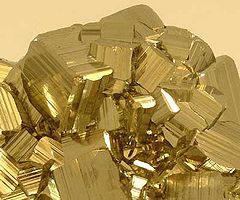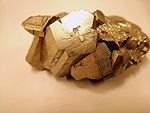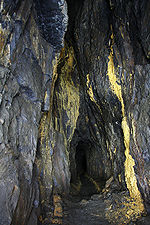Pyrite
| Pyrite | |
|---|---|
 | |
| General | |
| Category | Pyrite Group |
| Formula (repeating unit) |
FeS2 |
| Strunz classification | 2.EB.05a |
| Dana classification | 2.12.1.1 |
| Unit cell | a = 5.417, Z = 4; V = 158.96 Den(Calc)= 5.01 |
| Identification | |
| Formula mass | 119.98 gm |
| Color | Pale brass-yellow |
| Cleavage | Poor/Indistinct, Indistinct on {001}. |
| Fracture | Irregular/Uneven, Conchoidal |
| Tenacity | Brittle |
| Mohs scale hardness | 6 - 6½ |
| Luster | Metallic |
| Streak | Greenish-black |
| Diaphaneity | Opaque |
| Specific gravity | 4.95 - 5.10 |
| Density | 4.8 - 5 g/cm3 |
| Melting point | 1,177-1,188°C |
| Fusibility | 2.5-3 |
| References | [2] |
Pyrite is a mineral belonging to the pyrite group. Pyrite is a very common mineral found in many different formations of rock. Since pyrite has a similar color to gold, so many in the past have confused it with being gold and now the most common name of pyrite is fool's gold. Pyrite is easily distinguishable from gold because gold can be scratched with a fingernail, whereas pyrite is much harder and will not be scratched. Also, pyrite is much lighter than gold. Pyrite got its name from the Greek word "pyr", which means fire. The reason pyrite got its name from this Greek word is because when pyrite is stricken against metal it sparks. Pyrite contains mostly Iron and Sulfur, but it may contain other elements such as cobalt, nickel, lead, gold, and arsenic, but these other elements are only in small amounts.[1]
Properties
Pyrite consists of both iron and sulfur, making it an iron sulfide mineral. This mineral has a brassy yellow color that leaves a greenish black to brownish black streak. This mineral is opaque, meaning it is not transparent, so it cannot be seen through. Pyrite is brittle, meaning it will break when too much force is applied. Other substances are malleable which means they will bend, not break when exposed to a certain amount of pressure.[3] On the mohs scale pyrite has a hardness of 6-6.5. The cleavage is indistinct, meaning there is no definite cleavage shape.[4]
Occurrences
Pyrite occurs very abundantly in the earth's crust. Pyrite occurs in almost every habitat or environment. This is the reason there are quite a few forms it can be found in. While pyrite may often be confused for gold, it also may mean gold is near; pyrite is affiliated with the presence of gold. Of all the sulfide minerals, pyrite is the most common.[4] Pyrite is mined in many places around the world, some of the most notable places pyrite is mined from are Peru, Italy, and Spain. Pyrite is found in many other places, but these are where most of the pyrite mining takes place. In the United States there are many places pyrite is found, but most of the pyrite is not near the quality of the pyrite found in other places.[5]
Uses
Pyrite is not very commonly mined for obtaining iron, more often it is mined for its sulfur content. Pyrite is not mined for the iron possibly because it is not found in as large quantities as other iron ores such as hematite and magnetite. It is also not mined for the iron because the iron becomes brittle after being apart of iron pyrite and it therefore has no great purpose. Other than pure sulfur sources, pyrite is the major sulfur provider. During World War 2 sulfur was a needed chemical, and the mines containing sulfur, were running low, so Americans started using pyrite as a source of sulfur production. The sulfur collected from pyrite during this time, was used to create sulfuric acid which is important as an industrial used chemical.[4] Another reason pyrite is mined is because it may sometimes contain gold and therefore is mined for the gold content. Native Americans sometimes used pyrite as mirrors, they would take the pyrite and polish it, making it usable as a mirror. Even during modern times, pyrite may be used decoratively as an ornamental stone.[5] The main uses for pyrite are producing sulfur dioxide and sulfuric acid. The sulfur dioxide made by pyrite is mostly used in the paper industry. While the sulfuric acid created from pyrite is used in the chemical industry. Now, pyrite is becoming less used because other substances that are easier accessed are replacing pyrite.[3] Photovoltaic solar panels are a low cost solar panel created by copper sulfide and pyrite. Historically, pyrite has been used to much more benefit than in modern times. Ancient people have used this to do things such as start a fire. In Greek and Roman culture, people would let pyrite weather and then boil the acid runoff with iron to make iron sulfate. After firearms were invented, pyrite was used to ignite the gunpowder.[6]
Crystallography
Pyrite may form into many different shapes such as cubes, octahedrons, and pyritohedrons. Pyrite's shape is determined by many different factors. These factors are temperature, pressure, and what type of rock it is formed in. If the temperature is around 250oC then the crystal that is formed will be needle-like. During the increase in temperature to about 450oC, the pyrite will take shape into first a cube, then an octehedron, then finally at the highest temperature the shape of the pyrite will be a pyritohedron, which is a twelve faced structure each face being pentagonal. Sometimes during the formation of pyrite the temperature will change very often, this change in temperature can cause the formation of the pyrite to change. This will ultimately cause the pyrite to look like a mix of two different shapes, either cube-octahedrons or octahedral-pyritohedrons. The constant change in temperature also leaves lines on the faces of the pyrite, because of this continual change from forming one shape to forming another. When multiple cubic pyrite are forming, they often create penetrating twins which happens when two of the cubic pyrite grow into or out of each other. Pyrite can also form into many other various structures such as radiating, grainy, flaky, mammilary, encrusting, nodular, and fibrous crystals. Also they can form as flattened disks, given the name "pyrite suns". [6] Another mineral that is almost the same as pyrite is marcasite. This rarer mineral has the same chemical formula(FeS2), but they both crystalize differently. So because of the difference in structure, pyrite and marcasite are not classified as the same mineral.[5] In some cases, pyrite weathers really easily. The way pyrite is formed, determines whether it will weather easily or not. The pyrite formed at higher temperatures tend to be more stable and oxidize a lot slower than those formed at low temperature. As pyrite oxidizes, it releases sulfuric acid.[1]
References
- ↑ 1.0 1.1 1.2 Ralph, Jolyon. Pyrite mindat.org. Web. Access February 27, 2012.
- ↑ Pyrite New World Encyclopedia. Web. Last Update 2 April 2008. Author Unknown
- ↑ 3.0 3.1 Pyrite - Mineral Properties and Uses Geology.com. Web. Accessed on March 16, 2013. Author Unknown
- ↑ 4.0 4.1 4.2 Pyrite Department of Chemistry. Web. Accessed on March 16, 2013. Author Unknown
- ↑ 5.0 5.1 5.2 THE MINERAL PYRITE The Mineral and Gemstone Kingdom. Web. Accessed on March 16, 2013. Author Unknown
- ↑ 6.0 6.1 Greene, Eric. PYRITE (FOOL'S GOLD): IT'S FOR COLLECTORS, NOT FOR FOOLS! Treasure Mountain Mining. Web. Accessed on March 17, 2013.
| ||||||||||||||


